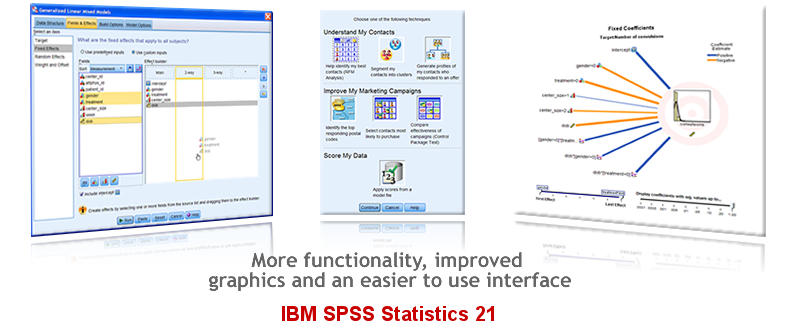IBM SPSS Statistics Family
The world’s leading statistical software for business, government, research and academic organizations.
Whether you are a beginner or an experienced analyst or statistician, IBM® SPSS® Statistics puts the power of advanced statistical analysis in your hands.

Why IBM
IBM SPSS Statistics is a comprehensive, easy-to-use set of data and predictive analytics tools for business users, analysts and statistical programmers. Learn more about IBM SPSS Statistics products and capabilities.
What We Offer
IBM SPSS Statistics Standard
Fundamental analytical capabilities for a wide variety of business and research questions
IBM SPSS Statistics Professional
Additional capabilities to address issues of data quality, data complexity, automation and forecasting
IBM SPSS Statistics Premium
A full range of analytical techniques plus structural equation modeling (SEM), in-depth sampling assessment and testing, and procedures for direct marketing.
All Statistics Products
What's New in IBM SPSS Statistics 21
IBM SPSS Statistics 21 continues to increase accessibility to advanced analytics through improved tools, output, and eas-of-use features. Here's a look at some of the groundbreaking new features you'll find in SPSS Statistics 21. They're designed to help you create better predictive models, assess risk more accurately, work faster and improve analytical performance.
-
Compare predicted outcomes for better decisions with Monte Carlo simulation
Get more reliable answers to your most important questions using Monte Carlo simulation techniques.
- Create simulated datasets based on existing data and/or known parameters when the existing data is inadequate
- Use that simulated data as input to predict an outcome.
- Adjust the parameters you used to simulate the data and compare multiple outcomes. For example, simulate different advertising budget amounts to see how they are likely to affect total sales.
- Build predictive models that help drive better decisions and reduce risk.
-
Program using a Java plug-in
Call SPSS Statistics functionality from a Java application and have SPSS Statistics output appear in the Java application. You can also use Java to control, react to and embed program logic into your SPSS Statistics jobs.
-
Compare data files
Increase the accuracy of your analysis by comparing two datasets or files in SPSS Statistics to identify any discrepancies between them.
Compare document metadata or perform a case-by-case comparison of selected variable values
- Increase data security
Apply password protection to your data and output files to prevent others from seeing confidential information in SPSS Statistics.
-
Work with large data faster and increase scalability and stability
IBM SPSS Statistics Server makes working with large data faster and more scalable, and improves overall stability.
- Single sign-on between the SPSS Statistics client and SPSS Statistics Server improves ease of use.
- Improved security enables it to run as non-root on Unix/Linux.
- Client and server software can be on different release levels (for example, client V21 and server V20), simplifiying administration.
-
Specify models without programming
Specify a model in IBM SPSS Amos without drawing a path diagram and enter it into a familiar spreadsheet-like table you can modify.
This approach improves the productivity of users who need to run large, complicated models, and makes it easy to generate many similar models that differ slightly.
- Serving productivity improvements
IBM SPSS Statistics enables you to:
- Work with pivot tables using features such as sorting operations, a navigation pane and search operations and more.
- Produce descriptive statistics (e.g. Frequencies or Descriptives) by right clicking on a variable in the Data Editor (when in Variable View or Data View).
- Use a smaller file compression algorithm that takes up less space on the disk, leaving more room for your data
- Merge data files and table lookup files without sorting by key variables, merge open datasets and/or external Statistics-format data files, use SQL-like statements to specify a merge and combine files using string key variables of different defined lengths in each file.


